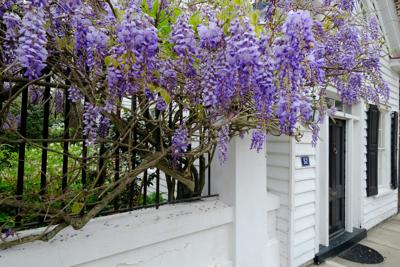Native Choices
Have you noticed the purple wisteria overwhelming trees along the roadsides? Chinese and Japanese wisteria (Wisteria sinensis and Wisteria floribunda) display pendulous racemes (clusters) of breathtakingly gorgeous flowers, but their aggressive growth overshadows their beauty. These non-native, invasive vines can girdle even large trees. Do not plant Asian wisteria. Instead choose the native American wisteria (Wisteria frutescens) which offers comparable beauty without the sinister growth habit. Native plants are almost always preferable to Asian imports.
Wisteria is an excellent example of why we should generally select native cultivars. American wisteria (Wisteria frutescens) is native from Virginia to Florida. Wisteria frutescens is a woody, deciduous, perennial climbing vine, one of various wisterias of the family Fabaceae. Another native wisteria is Kentucky wisteria, Wisteria frutescens var. macrostachya, a distinctive variety found in the southeast, including its namesake state of Kentucky.
American wisteria prefers moist soils. It is considered shade tolerant but will flower only when exposed to partial or full sun. It grows best in USDA plant hardiness zones 5-9. In the wild, they can be found in woods, thickets and streambanks.
Several characteristics distinguish American wisteria from its Asian counterparts. It grows only two-thirds as tall. Its racemes are half as long (the shortest of the wisteria family), and its bloom time is sometimes shorter than many Asian varieties. According to Robert Polomski, American wisteria blooms about three weeks after the Asian types. Its pendulous, rounded clusters of pale lavender pealike flowers emerge at the branch tips. Its flowers are scented, and its seed pods are smooth rather than velvety when mature. The flowers of American wisteria are a bit less showy, but they offer a dramatic effect without posing an ecological threat. Many bonsai artists employ American wisteria for its manageably-sized flowers, and it is charming as a woodland flowering vine.
Named for its dark lavender-hued flowers, the selection Amethyst Falls is a vigorous climber that is attractive to butterflies and other pollinators and is deer and drought resistant. Amethyst falls was discovered as a stem mutation by plantsmen Bill and Bob Head in Seneca. It tends to rebloom with greater vigor than the species in mid- and late summer. Other noteworthy cultivars of American wisteria include Longwood Purple, which has deeper bluish-purple hues, and Nivea with white flowers.
Native selections are almost always better for a number of reasons, but occasionally the native plant is not always the best choice. For example, our beautiful native flowering dogwoods have been affected by a relatively new disease threatening dogwoods in our area. Even though Cornus florida is well adapted to our area, dogwood anthracnose (also called discula anthracnose) is now affecting native dogwoods in my garden. I will soon need to replace several infected trees.
In this case, an Asian cousin, Kousa dogwood (Cornus kousa) is generally resistant to dogwood anthracnose and is actually a better choice for replanting in areas where native dogwoods have died from disease. Native dogwoods bloom before foliage emerges in April, while Kousa dogwoods flower nearly a month later, with flowers nestled among fresh green leaves. A tree for all seasons, the Kousa dogwood has berries that resemble raspberry fruit in autumn, and the peeling bark on the mature tree trunks has an attractive mottled appearance. The fall leaf color is reddish-purple to scarlet. Sometimes, the non-native choice is preferable, but it’s not very often.
Get to know the pros and cons of native plants. The Aiken Master Gardener Association has a good working relationship with native plant societies in our state. The South Carolina Native Plant Society is dedicated to educating the public about the value of native plants, safeguarding native habitats and promoting the use of native plants into both public and private landscapes. Until recently, Aiken residents interested in participating in meetings, lectures or educational excursions had to travel to Columbia to engage with the closest native plant chapter. Now, Aiken is on the verge of establishing its own chapter of the South Carolina Native Plant Society. Formal approval has been granted, and plans are to start holding monthly meetings beginning this spring.
We are truly blessed to have a significant number of beautiful native plants in our area. We can also learn more about the plants that are more likely to succeed in our landscapes. Native plants have evolved in place over time; therefore, these plants tend to be hardy and well-adapted in the residential or commercial landscape. In many cases, established native plants can grow with little to no fertilizer and pesticides, and may require little to no irrigation. In this way, native plants generally help protect water resources, allowing gardeners to reduce fertilizers, pesticides, and irrigation practices which otherwise can contribute to stormwater runoff pollution and degradation of downstream water quality.
Many national wildlife organizations also urge gardeners to heed the call to support wildlife by planting natives. The National Wildlife Federation’s online plant database, searchable by ZIP code, focuses on the best plants to sustain moth and butterfly caterpillars. These caterpillars, in turn, provide food for many other animals. The Audubon Society also has a ZIP code search to find plants to attract and support specific native birds. The Xerces Society and Pollinator Partnership have developed helpful regional planting guides specifically for pollinators. These guides are available for free on their websites.
As always, selecting the right plant for the right place is important. Choosing a native plant is often more appropriate for local climate, precipitation, and soil which will increase the likelihood of plant survival.
The AMGA Lunchbox series will host Paul Thompson at Millbrook on Friday, April 19, to present a program on “Natives in the Shade.” Paul is the County Extension Agent-Urban Horticulture for Chester, Lancaster, and York County Cooperative Extension Offices.



